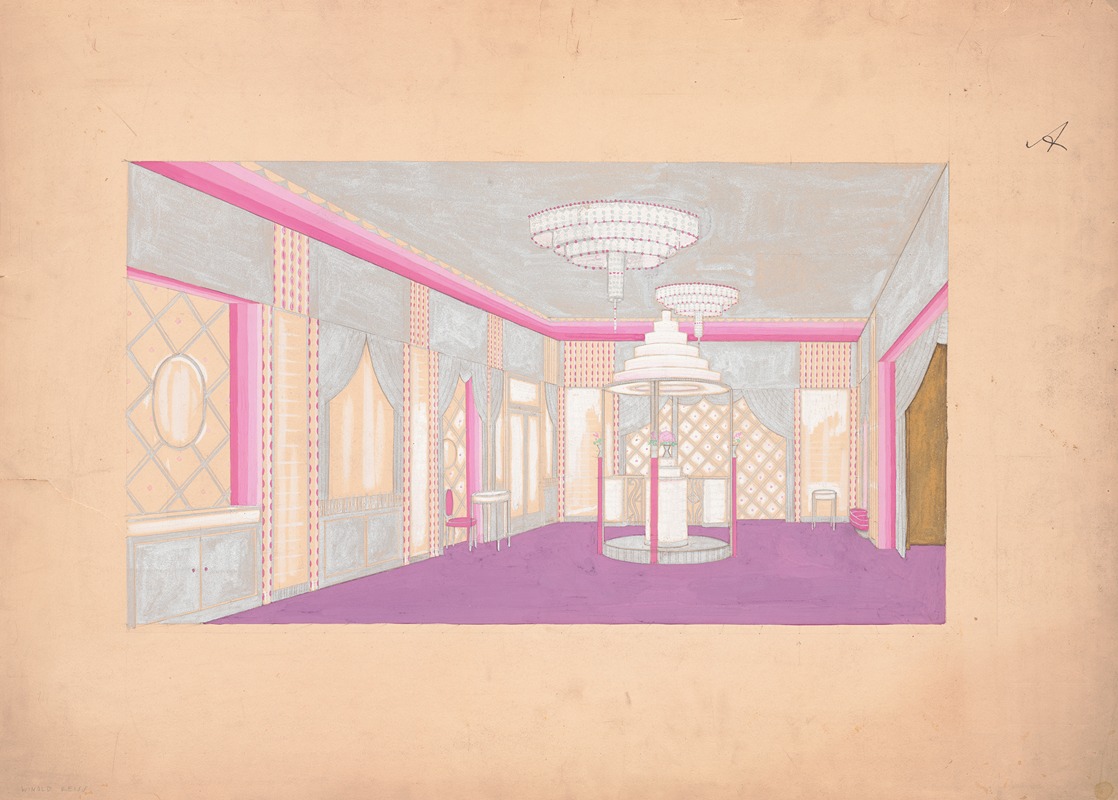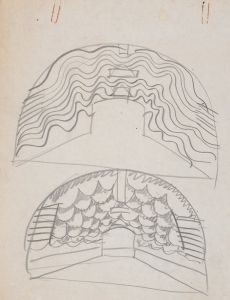
[Design for the Lentheric Salon, Fifth Ave. & 58th St., Savoy-Plaza Hotel, New York, NY.] [Perspective rendering
A hand-painted replica of Winold Reiss’s masterpiece [Design for the Lentheric Salon, Fifth Ave. & 58th St., Savoy-Plaza Hotel, New York, NY.] [Perspective rendering, meticulously crafted by professional artists to capture the true essence of the original. Each piece is created with museum-quality canvas and rare mineral pigments, carefully painted by experienced artists with delicate brushstrokes and rich, layered colors to perfectly recreate the texture of the original artwork. Unlike machine-printed reproductions, this hand-painted version brings the painting to life, infused with the artist’s emotions and skill in every stroke. Whether for personal collection or home decoration, it instantly elevates the artistic atmosphere of any space.
Winold Reiss was a German-American artist known for his work in portraiture, graphic design, and interior design. He was born in 1886 in Karlsruhe, Germany, and emigrated to the United States in 1913. Reiss's artistic style was heavily influenced by his European training and his interest in diverse cultures, which he encountered in America. He is particularly noted for his portraits of Native Americans and African Americans, as well as his contributions to modernist design.
The "Design for the Lentheric Salon, Fifth Ave. & 58th St., Savoy-Plaza Hotel, New York, NY" is a perspective rendering by Winold Reiss. This work is a representation of Reiss's involvement in interior design, showcasing his ability to blend artistic aesthetics with functional space planning. The Lentheric Salon was located in the Savoy-Plaza Hotel, a prominent hotel in New York City that opened in 1927 and was known for its luxurious accommodations and prime location at Fifth Avenue and 58th Street.
Reiss's design for the Lentheric Salon would have been part of the hotel's effort to offer an opulent and stylish experience to its guests. Lentheric was a well-known French perfume and cosmetics company, and having a salon in such a prestigious location would have been significant for its brand image. The design likely reflected the Art Deco style, which was prevalent during the 1920s and 1930s, characterized by bold geometric patterns, rich colors, and lavish ornamentation.
Reiss's work in interior design often incorporated elements of modernism and cultural motifs, which might have been evident in the salon's design. His ability to integrate artistic elements into commercial spaces made his work stand out. The rendering would have served as a visual proposal, illustrating how the space would look once completed, and would have been used to communicate the design concept to clients and stakeholders.
The Savoy-Plaza Hotel itself was an architectural landmark, designed by McKim, Mead & White, a prominent architectural firm. It stood as a symbol of the opulence and modernity of New York City during the early 20th century. Unfortunately, the hotel was demolished in 1965 to make way for the construction of the General Motors Building, which now occupies the site.
Winold Reiss's contribution to the design of the Lentheric Salon is a testament to his versatility as an artist and designer. His work not only enhanced the aesthetic appeal of commercial spaces but also reflected the cultural and artistic trends of his time. While specific details about the design elements of the Lentheric Salon are not extensively documented, Reiss's reputation and body of work suggest that it would have been a sophisticated and visually striking space.
Overall, Reiss's rendering for the Lentheric Salon represents a fusion of art and commerce, showcasing how artistic vision can be applied to enhance the functionality and appeal of commercial interiors. His work remains an important part of the history of design and architecture in the United States.






![Design drawings for Club Gallant project, New York, NY.] [Study for Club Gallant exterior](/imgs/249273/s/winold-reiss-design-drawings-for-club-gallant-project-new-york-ny-study-for-club-gallant-exterior-822ea339.jpg)
![Design drawings for the Theodore Weicker Apartment Building.] [Study for metalwork gate](/imgs/249281/s/winold-reiss-design-drawings-for-the-theodore-weicker-apartment-building-study-for-metalwork-gate-8a05d5e9.jpg)
![Design for fine art print, ‘The Mad Dancer’.] [Woodcut print](/imgs/249286/s/winold-reiss-design-for-fine-art-print-the-mad-dancer-woodcut-print-c03b5ea2.jpg)
![Design for unidentified ballroom, probably New York City area.] [Perspective rendering in vermillion and gold](/imgs/249296/s/winold-reiss-design-for-unidentified-ballroom-probably-new-york-city-area-perspective-rendering-in-vermillion-and-gold-a55c65e4.jpg)
![Design for unidentified interior.] [Drawing of columned hall with altar on a stepped plinth and decorative frieze featuring elephants](/imgs/249300/s/winold-reiss-design-for-unidentified-interior-drawing-of-columned-hall-with-altar-on-a-stepped-plinth-and-decorative-frieze-featuring-elephants-5fe6009d.jpg)
![Designs for Modern Hotel Suite, Du Pont Biltmore Hotel, Wilmington, Delaware.] Colour chart for Suite 210](/imgs/249317/s/winold-reiss-designs-for-modern-hotel-suite-du-pont-biltmore-hotel-wilmington-delaware-colour-chart-for-suite-210-70bfb090.jpg)
![Drawings for proposed decorations of Mike Lyman’s Restaurant, 424 W. Sixth St., Los Angeles, CA.] [Color scheme for ceiling, playroom – bar – foyer](/imgs/249337/s/winold-reiss-drawings-for-proposed-decorations-of-mike-lymans-restaurant-424-w-sixth-st-los-angeles-ca-color-scheme-for-ceiling-playroom-bar-foyer-ba71c61c.jpg)
![Drawings for proposed redecorations of Yorketowne Coffee Shop, Job #238, York, PA.] [Drawing #6, interior plans for tables, counters, benches](/imgs/249341/s/winold-reiss-drawings-for-proposed-redecorations-of-yorketowne-coffee-shop-job-238-york-pa-drawing-6-interior-plans-for-tables-counters-benches-c6e96b9c.jpg)

![Miscellaneous small sketches for inlaid table tops.] [Design with orange and yellow geometric motif](/imgs/249438/s/winold-reiss-miscellaneous-small-sketches-for-inlaid-table-tops-design-with-orange-and-yellow-geometric-motif-9009d68a.jpg)


